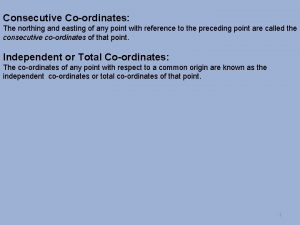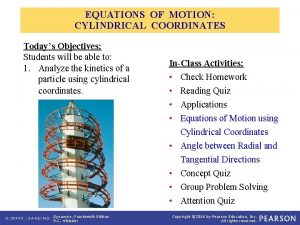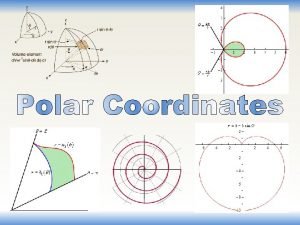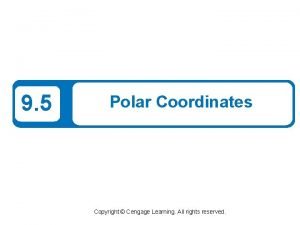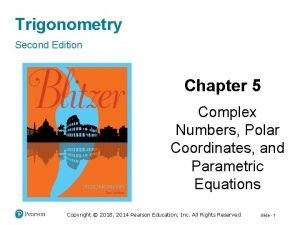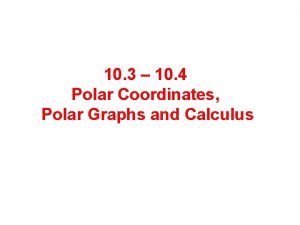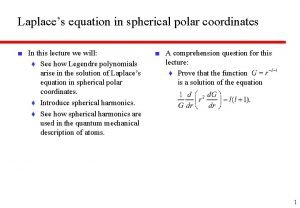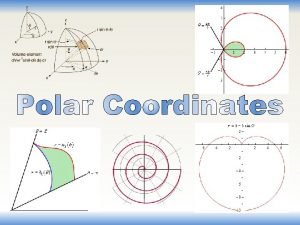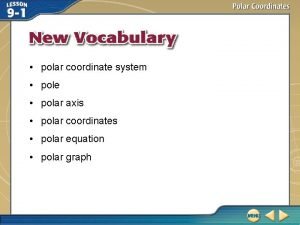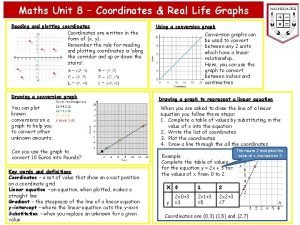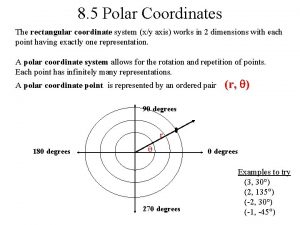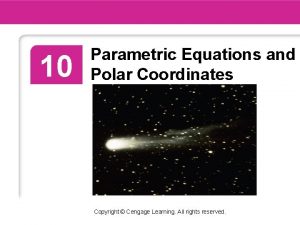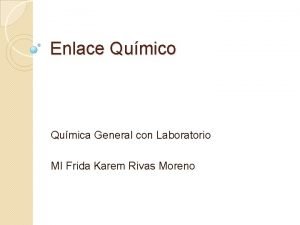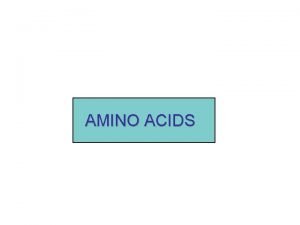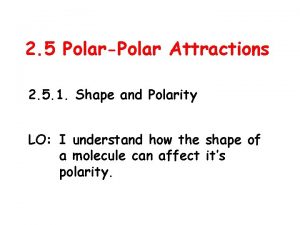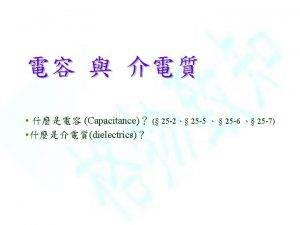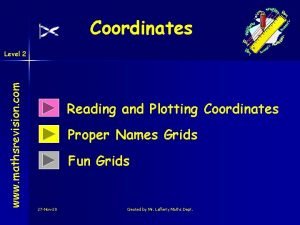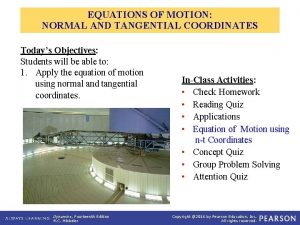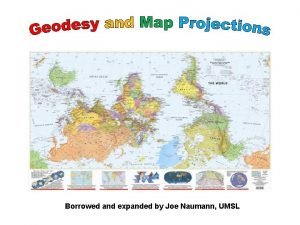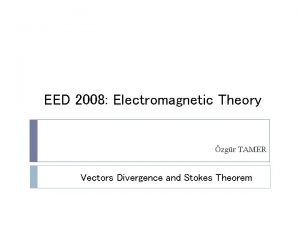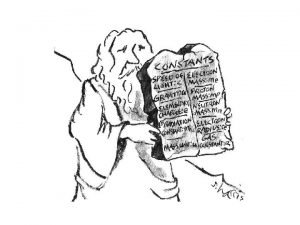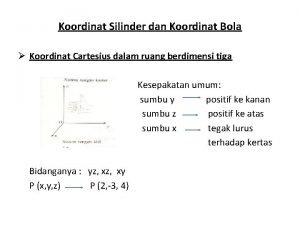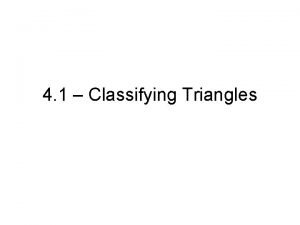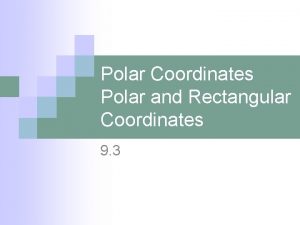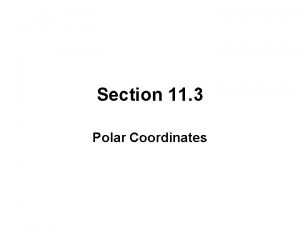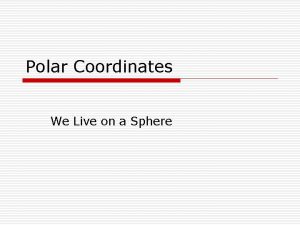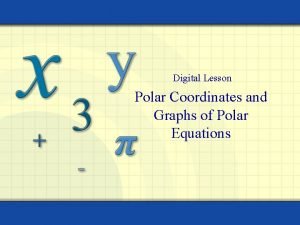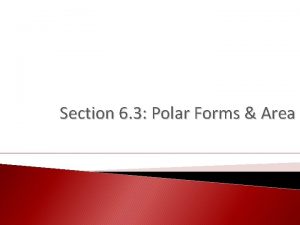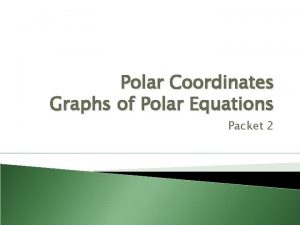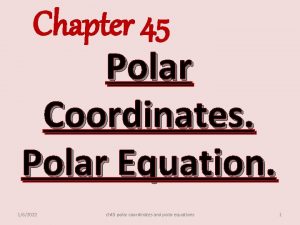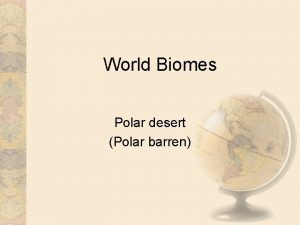MATH 1330 Polar Coordinates Polar Coordinates Polar coordinates





















































- Slides: 53

MATH 1330 Polar Coordinates

Polar Coordinates Polar coordinates define every point as a distance (r) from a central point (the pole), and an angle (θ) from a central line (the polar axis). (r, θ) r θ

Multiple Representations Since polar points are angular in their definition, one point can be represented in numerous ways. (r, θ) = (r, θ + 2 nπ) (r, θ) θ+2π θ

Negative r - values If the r – value is negative r – value, think of this: If you are facing the angle of π/3 and walk backwards a distance of 5, you be at the point: (-5, π/3)

Negative r - values

Multiple Representations Since polar points are angular in their definition, one point can be represented in numerous ways. (r, θ) = (r, θ + 2 nπ) (r, θ) = (-r, θ +[2 n+1]π) (r, θ) θ+π -r θ

Determine which coordinate does not represent the same point as the others. (5, π/3) (5, 7π/3) (-5, 4π/3) (-5, 7π/3)

Determine which coordinate does not represent the same point as the others. (5, π/3) = (r, θ) (5, 7π/3) = (r, θ + 2π) (-5, 4π/3) = (-r, θ + π) (-5, 7π/3) = (-r, θ + 2π)

Determine which coordinate does not represent the same point as the others. (5, π/3) = (r, θ) (5, 7π/3) = (r, θ + 2π) All the same point (-5, 4π/3) = (-r, θ + π) (-5, 7π/3) = (-r, θ + 2π) Different point

Conversion between Rectangular and Polar Coordinates x = r cos θ y = r sin θ θ = arctan y/x r 2 = x 2 + y 2

Convert from Rectangular into Polar (5, 2) (-6, 1)

Convert from Polar into Rectangular (3, π/6) (-2, π/4)

Polar Graphs Convert the following graphs into polar coordinates: x 2 + y 2 = 16 (x-2)2 + y 2 = 4 x 2 + (y-3)2 = 9

Polar Graphs Convert the following graphs into polar coordinates: x 2 + y 2 = 16 (x-2)2 + y 2 = 4 x 2 + (y-3)2 = 9 r 2 = 16 r=4

Polar Graphs Convert the following graphs into polar coordinates: x 2 + y 2 = 16 r 2 = 16 (x-2)2 + y 2 = 4 (rcosθ – 2)2 + (rsinθ)2 = 4 r 2 cos 2θ – 4 rcosθ + 4 + r 2 sin 2θ=4 r 2 = 4 rcosθ r = 4 cos θ x 2 + (y-3)2 = 9 r=4

Polar Graphs Convert the following graphs into polar coordinates: x 2 + y 2 = 16 r=4 (x-2)2 + y 2 = 4 r = 4 cos θ x 2 + (y-3)2 = 9 r = 6 sin θ

r=5

r = 8 sin θ

r = 6 cos θ

Lines Convert the following into polar coordinates: y=6 x=5 y=x y = 2 x + 3

Lines Convert the following into polar coordinates: y=6 r sinθ = 6 x=5 y=x y = 2 x + 3

Lines Convert the following into polar coordinates: y=6 r sinθ = 6 r = 6 csc θ x=5 y=x y = 2 x + 3

Lines Convert the following into polar coordinates: y=6 r = 6 csc θ x=5 y=x y = 2 x + 3 r = 5 sec θ

Lines Convert the following into polar coordinates: y=6 r = 6 csc θ x=5 r = 5 sec θ y=x y/ y = 2 x + 3 x =1

Lines Convert the following into polar coordinates: y=6 r = 6 csc θ x=5 r = 5 sec θ y=x y/ y = 2 x + 3 y/ )= arctan 1 = 1 arctan( x x

Lines Convert the following into polar coordinates: y=6 r = 6 csc θ x=5 r = 5 sec θ y=x y/ y = 2 x + 3 y/ )= arctan 1 = 1 arctan( x x θ = π /4

Lines Convert the following into polar coordinates: y=6 r = 6 csc θ x=5 r = 5 sec θ y=x θ = π /4 y = 2 x + 3

Lines Convert the following into polar coordinates: y=6 r = 6 csc θ x=5 r = 5 sec θ y=x θ = π /4 y = 2 x + 3 y – 2 x = 3

Lines Convert the following into polar coordinates: y=6 r = 6 csc θ x=5 r = 5 sec θ y=x θ = π /4 y = 2 x + 3 y – 2 x = 3 rsinθ – 2 rcosθ = 3

Lines Convert the following into polar coordinates: y=6 r = 6 csc θ x=5 r = 5 sec θ y=x θ = π /4 y = 2 x + 3 y – 2 x = 3 rsinθ – 2 rcosθ = 3 r = 3/sinθ – 2 cosθ

Lines Convert the following into polar coordinates: y=6 r = 6 csc θ x=5 r = 5 sec θ y=x θ = π /4 y = 2 x + 3 r = 3/sinθ – 2 cosθ

r = 3 csc θ

r = 2 sec θ


r = 5/2 cosθ + 3 sinθ

Polar Graphs: Rose Curves: r = 5 sin (3θ) r = 2 cos (2θ) Rose Curves are always of the form: r = a sin (nθ) or r = a cos (nθ). Based on your graphs, how can you determine the length of each petal of the rose-curve? How can you determine the number of petal in the entire graph? (Hint: there are different rules for even n-values and odd n-values. )

Polar Graphs: Lemiҫons: This is pronounced Lee-Mah-Zon. r = 3 + 2 sin θ r = 3 – 6 cos θ r = 4 + 4 sin θ r = 5 + 2 cos θ Lemiҫons are always of the form r = a ± b sin θ or r = a ± b cos θ. They are categorized in four groups: convex, dimpled, cardioid, and with inner loop. The value of b/a will determine which of these categories it fits into.

Lemiҫons Based on your graphs and some vocabulary (such as cardio meaning heart-related) determine which of the above equations become which classifications. Then determine the value of b/a that would create these graphs. Convex: Dimpled: Cardioid: Inner Loop: Example (from above): b/ <½ ½ < b/a < 1 b/ = 1 a b/ > 1 a a

Polar Graphs: Lemnoscates: r 2 = 16 sin (2θ) r 2 = 9 cos (2θ) r 2 = -25 sin(2θ) r 2 = -4 cos (2θ) Remember, you are calculating and plotting r – values, not r 2 values. If r 2 is negative, then no point can be plotted.

r = 2 + 4 sin θ

r = 2 + 4 sin θ r = 2 + 4 sin 0

r = 2 + 4 sin θ r = 2 + 4 sin 0 r=2+0

r = 2 + 4 sin θ r = 2 + 4 sin 0 r=2+0 r=2

r = 2 + 4 sin θ r = 2 + 4 sin 0 r=2+0 r=2

r = 2 + 4 sin θ

Animation of the graph: https: //www. desmos. com/calculator/a 4 i 6 rodk 73

r = 2 + 4 sin θ

That is a Limiҫon with an Inner Loop

You can get all 4 kinds of Limiҫons based on the constants in the equation. View the following animation: https: //www. desmos. com/calculator/vxzfq 85 gnd

Try These: r = 2 cos (2θ)

Try These: r 2 = -4 cos (2θ)

Conics in Polar Form: •

Identify the conic section:
 Cartesian to polar unit vectors
Cartesian to polar unit vectors Zuzana 1330
Zuzana 1330 Decreto 1330 de 2019 power point
Decreto 1330 de 2019 power point Engr 1330
Engr 1330 Opnav 5239 14
Opnav 5239 14 Engr 1330
Engr 1330 Homogeneous coordinates vs cartesian coordinates
Homogeneous coordinates vs cartesian coordinates Consecutive coordinates in surveying
Consecutive coordinates in surveying Polar coordinates dynamics examples
Polar coordinates dynamics examples Polar and rectangular forms of equations
Polar and rectangular forms of equations Conic sections in polar coordinates
Conic sections in polar coordinates Polar coordinates
Polar coordinates Double integral in polar coordinates
Double integral in polar coordinates How to add in polar form
How to add in polar form Convex limacon
Convex limacon Multiple representations of polar coordinates
Multiple representations of polar coordinates How to find polar coordinates
How to find polar coordinates Arc length polar
Arc length polar Polar parameterization
Polar parameterization Laplace equation in spherical polar coordinates
Laplace equation in spherical polar coordinates Symmetry test for polar graphs
Symmetry test for polar graphs Alternative polar coordinates
Alternative polar coordinates Pole in polar coordinates
Pole in polar coordinates Limit and continuity
Limit and continuity Polar fft
Polar fft Conic sections in polar coordinates
Conic sections in polar coordinates Y=rsin
Y=rsin Real life graphs
Real life graphs Polar coordinate art
Polar coordinate art Polar coordinates to rectangular
Polar coordinates to rectangular Parametric equations and polar coordinates
Parametric equations and polar coordinates Enlace dativo
Enlace dativo Essential amino acids arginine
Essential amino acids arginine Polar polar attractions
Polar polar attractions What is polar covalent bond and nonpolar covalent bond
What is polar covalent bond and nonpolar covalent bond Polar and non polar dielectrics
Polar and non polar dielectrics Sustancias ionicas
Sustancias ionicas Topmarks
Topmarks Www.mathsrevision.com
Www.mathsrevision.com Where waldo google maps coordinates
Where waldo google maps coordinates Equations of motion: normal and tangential coordinates
Equations of motion: normal and tangential coordinates Homogeneous coordinates in computer graphics
Homogeneous coordinates in computer graphics Where is 0 0 coordinates on earth
Where is 0 0 coordinates on earth Curl in spherical coordinates
Curl in spherical coordinates Ignorable coordinates
Ignorable coordinates South pole coordinates
South pole coordinates Sistem koordinat bola
Sistem koordinat bola Which system coordinates the body's response to changes
Which system coordinates the body's response to changes For coordinates p(2,3)the 4 neighbors of pixel p are
For coordinates p(2,3)the 4 neighbors of pixel p are How to classify a triangle by its sides with coordinates
How to classify a triangle by its sides with coordinates Pixel coordinates
Pixel coordinates Homogeneous coordinates in computer graphics
Homogeneous coordinates in computer graphics Area of parallelogram using coordinates
Area of parallelogram using coordinates Pygame coordinates
Pygame coordinates







